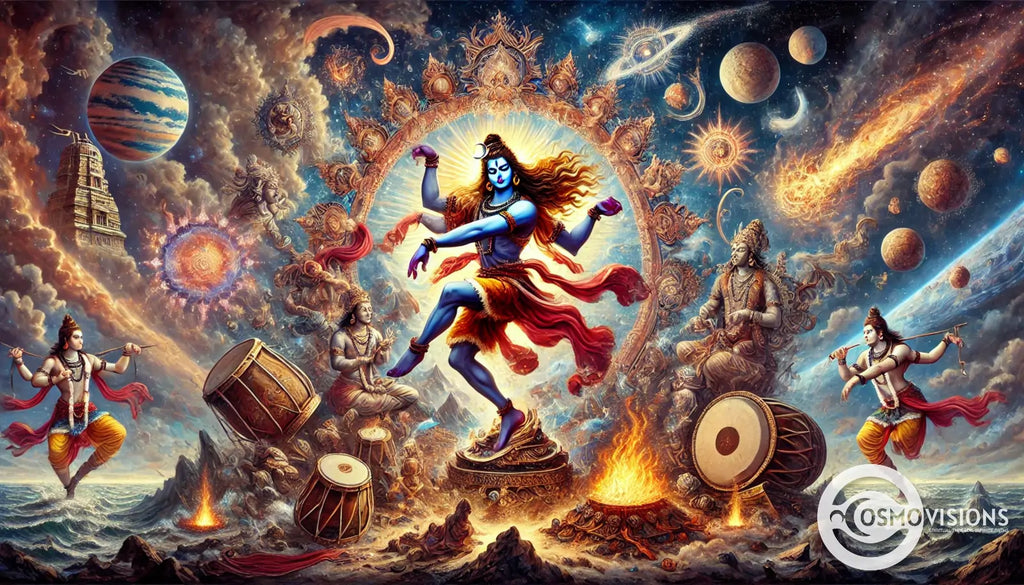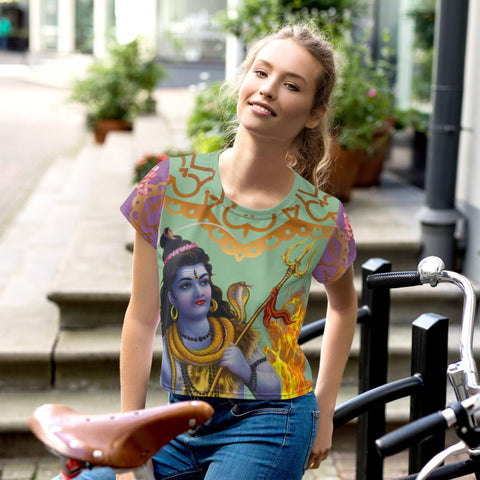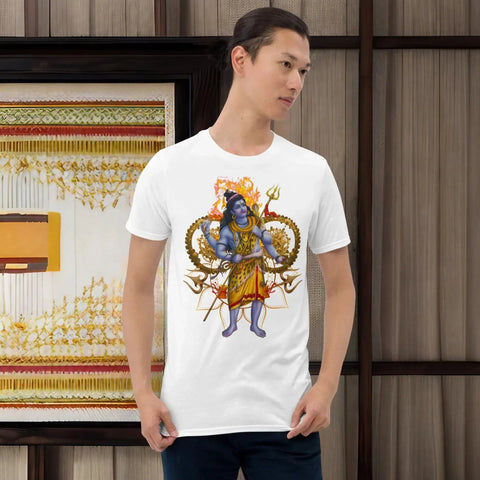Exploring the Power of Tandav Shiva and the Dance of Destruction
Posted by Massimiliano Geraci

Understanding the mysteries of life and the universe often leaves us searching for clarity and meaning in mundane world. Many find themselves drawn to exploring ancient traditions and practices, seeking insights that resonate with both mind and spirit.
Among these profound explorations is the power of Tandav Shiva, a hugely popular dance form that captures not just artistic expression but deep spiritual symbolism.
The Shiva Tandava, known as the dance of destruction performed by Lord Shiva, holds a pivotal place in Hindu mythology. It’s a cosmic dance that symbolizes creation, preservation, and dissolution—elements that govern our existence.
This article delves into this fascinating subject, revealing how Tandava connects us to universal truths through its dynamic forms like Rudra Tandava and Ananda Tandava. Discover how this divine art transcends mere movement to embody cycles of life and transformation.
Let’s explore together.
What is the Shiva Tandava?
Moving forward from the introduction, we delve into the concept of Shiva Tandava, a significant cosmic dance performed by Shiva. This profound expression captures the essence and dynamism of the universe, embodying both creation and destruction within its movements.
The term “Tandava” itself resonates with power, illustrating Shiva’s role as Nataraja, lord of dancers, where every posture and gesture signifies deeper layers of meaning spanning across spirituality, mythology, and philosophy.
Shiva’s energetic dance is more than just a display; it symbolizes the cycles of creation, preservation, and dissolution that define our existence in time and space. Described vividly in texts like the Shiva Tandava Stotra—a hymn believed to be composed by Ravana—this divine art form represents a state beyond mere physicality, touching on notions of ecstasy (ananda), ignorance (Avidya), knowledge (Vidya), and ultimate liberation (Moksha).
It articulates an aggressive yet blissful narrative that transcends verbal description, echoing through Hindu deities’ tales from Mount Kailash to South India’s temples. In a literal sense, the dance embodies rhythmic energy as a metaphysical metaphor.
Meaning and Significance of Shiva's Dance
Shiva’s Dance, known as Tandava, symbolizes the cosmic cycles of creation and destruction, embodying the very essence of the universe. Shiva denotes the profound nature of this dance through his two forms: the Ananda Tandava, a happy dance of bliss, and the Rudra Tandava, a dance of constructive destruction. This illustrates how life and death, destruction and rebirth are inseparable dualities in the vast expanse of existence.
Through his vigorous movements and expressive hand gestures, Shiva performs two forms of this dance to release suppressed anger which is paradoxically constructive because it paves the way for renewal.
Each element of Tandava reflects aspects of Shiva’s multifaceted nature - from his role as a destroyer to his benevolence in regeneration.
The significance of this dance extends beyond mere artistic expression; it is a window into Hindu philosophy’s intricate views on the cosmos and spirituality. By showcasing control over the destructive energies that rest within him, Shiva demonstrates that destruction isn’t about chaos but about making space for new creation.
His foot pressing down on Apasmara Purusha (the demon of ignorance) signifies overcoming ignorance and reaching enlightenment. The circle made by his hands represents both containment and eternal movement in time, highlighting that our physical world operates within these cosmic rhythms - constantly evolving yet eternally cyclical.

How does Tandava Represent the Universe?
Bridging the gap from the meaning and significance of Shiva’s dance, we explore how Tandava mirrors the universe. This powerful form of dance captures the essence of creation, preservation, and destruction—three fundamental aspects that govern our existence.
Through vigorous movements and expressions, Tandava depicts these universal cycles in a captivating performance. The god Shiva embodies these roles as creator, preserver, and destroyer, showcasing his dominion over time and space within the cosmic dance. In this divine performance, Shiva emerges in his purest form, revealing the intrinsic nature of Satchidananda—truth, consciousness, and bliss.
The imagery in Tandava is rich with symbolism reflecting various elements of the universe. For instance, Shiva’s drum symbolizes creation; it represents the sound from which everything originates.
His fire signifies destruction or transformation—leading to renewal. With each step and movement, Shiva crushes ignorance represented by a dwarf underfoot. Thus, through Tandava, he conveys profound truths about life: that change is inevitable and every ending paves way for a new beginning.
This dance becomes a metaphor for dynamic balance within nature where opposites coexist—creation with destruction—the very essence encapsulating our bound-by-time-and-space world.
Why is it Known as the Dance of Destruction?
Shiva's Tandava transitions from representing the universe to symbolizing its end, hence earning the title "Dance of Destruction" (Samhara Tandava). This aggressive form of dance showcases Shiva in his Rudra aspect, where he performs with intense energy that signifies both destruction and renewal.
It is this cosmic dance that leads to dissolution, clearing the path for a new cycle of creation.
The imagery of Shiva performing Tandava conveys a deeper message: destruction caused by Shiva is constructive at its core. In Hindu philosophy, this act is essential for removing illusion and ego, liberating souls for rebirth.
Through this divine performance, depicted vividly in tales like Daksha yajna and featured symbols such as the third ‘destructive’ eye and Nataraja, Shiva demonstrates that ending is merely a precursor to beginning.
This cycle reflects the continuous nature of the cosmos itself – bound by time and space yet eternally regenerative.
What are the Different Types of Tandava?
The Rudra Tandava and the Ananda Tandava stand as the two main forms of Shiva’s cosmic dance, each reflecting contrasting dimensions principle manifestations of his divine nature. The Rudra Tandava symbolizes Shiva’s most aggressive form, where he performs with a fierce expression, often in the context of destruction leading to creation. The Ananda Tandava reflects Shiva's purest nature and the experience of ecstasy.
This intense dance represents the release of suppressed anger and paves the way for new beginnings, illustrating cycles within the universe where endings make space for new growth. The Gauri Tandava, associated with Shiva's wife Parvati, is another dance form that complements Shiva's Tandava, known as Lasya dance.
On the other hand, Ananda Tandava depicts Shiva in a blissful state, performing with Uma by his side. This joyful dance signifies happiness and benevolence, embodying creation’s continuous cycle without destruction.
Each variation brings forward different aspects of Shiva that range from wrathful to joyful expressions, showing his multifaceted character in maintaining cosmic balance. The diversity between Rudra and Ananda Tandava reflects two distinct but diverse nature of life—destruction as a necessary precursor to rebirth and joyous creation celebrating existence itself.
Exploring these variations allows us to understand deeper layers of spiritual symbolism tied to Hindu mythology and Shaivism principles while appreciating classical Indian arts through depictions of these dances across various mediums like poetry, sculptures at temples such as Nataraja Temple at Chidambaram, and traditional performances.
Moving next into our exploration reveals how this intricate symbolism behind Shiva’s tandavas illuminates broader philosophies within Hinduism regarding cyclical universes’ nature and spirituality’s role therein.
The Rudra Tandava vs. The Ananda Tandava
Exploring the dichotomy between the Rudra Tandava and the Ananda Tandava unearths more profound meaning and layers of meaning within the tapestry of Hindu mythology. This comparison illuminates the duality of Shiva’s nature, encapsulating both the creator and the destroyer in their purest form.
AspectRudra TandavaAnanda TandavaDefinitionA vigorous dance that symbolizes destructionA gentle dance representing creation and blissDepictionShiva performs this dance in a ferocious and violent mood, often associated with the destruction of the universe.Shiva is depicted in a joyful mood, surrounded by flames that symbolize the cosmos.SymbolismRepresents the cycle of creation, preservation, and dissolution.Emphasizes the joy and ecstasy of creation.EnergyManifestation of Shiva’s destructive energy.Reflects Shiva’s benevolent aspects and creative energy.IconographyOften depicted with a drum, trident, and flames, signifying the destruction that precedes rebirth.Shiva is typically shown with a drum and fire, but with a demeanor that evokes peace and calmness.Impact on DevoteesInspires respect and awe for the forces of nature and the cycle of life and death.Encourages an understanding of the joyful aspects of the universe and the creative force within oneself.
Shiva’s Tandava dances, embodying the forces of creation and destruction, offer a window into the profound philosophical and theological underpinnings of Hinduism. Through the lens of the Rudra and Ananda Tandavas, devotees and scholars alike can gain insights into the dual nature of existence and the eternal cycle that governs the cosmos.
How Each Type Reflects Different Aspects of Shiva
The Rudra Tandava showcases Shiva's destructive aspect and his power as a destroyer, mirroring the cycle of creation, preservation, and destruction that characterizes the universe.
This dance is also a symbol of Shiva's anger and sorrow following Sati's (Hindu goddess) demise, highlighting how deeply divine emotions can influence natural and cosmic events. As Shiva performs most vicious form of this fierce dance with a powerful energy that even shakes the three worlds, it represents the purest aspect most aggressive form of his essence.
Here, each movement exudes strength and ferocity, depicting how destruction paves the way for new creation.
Contrastingly, Ananda Tandava reflects Shiva’s role as Nataraja - Lord of Dance - illustrating joyous aspects and benevolence through rhythmic ecstatic expressions. During this dance of bliss in front of Parvati at evening time signifies an act and also serves as a reminder that within every end lies a beginning filled with hope and happiness.
It captures the essence of eternal energy cycles where dissolution leads to regeneration. Through Ananda Tandava’s fluid motions against Chandrahasa (moon-bladed) background accompanied by celestial music from entities like Saraswati on Veena narrates stories overflowing with wisdom ecstasy germinates deep within enlightening souls about life's cyclical nature intertwined seamlessly with spiritual awakening.
Variations of Tandava Performed by Lord Shiva
Shiva’s Tandava, a powerful dance, symbolizes the cycle of creation, preservation, and destruction. This cosmic dance, performed by Lord Shiva, manifests in various forms, each reflecting different aspects of the universe and divine play. Here are some notable variations:
1. Rudra Tandava: Signifies Shiva’s role as the destroyer and is often associated with his fierce aspect. This form of Tandava is aggressive and energetic, embodying Shiva’s power to dismantle the world’s illusions and ignorance. It is said that Shiva performs Rudra Tandava in response to Sati’s self-immolation, showcasing his grief and anger.
2. Ananda Tandava: Reflects joy and bliss, portraying Shiva’s benevolent nature as Nataraja - Lord of Dance. This variation symbolizes the cosmos’s dynamic nature and the continuous cycle of creation and destruction. The Ananda Tandava is celebrated every year during Maha Shivaratri, highlighting its importance in spiritual practices. During Sandhya Tandava, gods like Brahma, Vishnu, Sarasvati, Lakshmi, and Indra play musical instruments and sing Shiva's praises.
3. Lasya Tandava: While not as widely recognized as Rudra or Ananda Tandava, Lasya Tandava showcases a gentler side of Shiva. Performed with graceful movements, it represents creation and beauty emerging from destruction. It’s said that this dance reassures Parvati (Shiva’s consort) of love and provides balance to the destructive forces. Uma Tandava is another type of Tandava found in Hindu texts, symbolizing the cosmic cycles of creation and destruction.
4. Tripura Tandava: Narrates Shiva’s role as a warrior destroying three cities (Tripura) built by demons that caused havoc in the universe. Through this dance, Shiva uses Chandrahasa (his bow) to end these cities with a single arrow – emphasizing themes of justice over injustice.
5. Samara Tandava: A less common variation involving a duel with the deity Ganesha demonstrates conflict leading to resolution and understanding within cosmic order explanations have noted how both deities display their strength before acknowledging mutual respect - epitomizing conflict resolution through divine intervention.
Each rendition of Tandava performed by Shiva communicates profound spiritual messages relevant across generations - transcending mere performance art into areas where myth meets meditation; action intertwines with enlightenment; human experiences find resonance with divine consciousness.
What is the Symbolism Behind Shiva's Tandava?
The Tandava, the dance performed by Shiva, conveys the complex feelings of creation and destruction, embodying the cyclic and violent nature of the universe. This dance signifies not just the end but also marks a way for the arrival of new beginnings.
Through its vigorous movements, Shiva comes across as both destroyer and rejuvenator, echoing the universal truth that life emerges from death. The symbolism extends to spiritual dimensions where this dance is viewed as a manifestation of divine energy.
Nataraja, a depiction most associated with this cosmic dance, stands on one foot suppressing ignorance symbolized by a demon lying beneath him. Surrounded by a circle representing the universe with fire that denotes transformation, Nataraja holds various objects in his arms and feet which convey essential life aspects — creation (drum), protection (hand gesture), destruction (fire), and release/salvation (raised foot).
These elements portrayed through Shiva’s Tandava reflect an intricate balance between different forces governing existence.
Understanding the Dance of Bliss and Destruction
Shiva’s Tandava encapsulates the essence of both creation and destruction, illustrating a universe in constant flux. Through the rhythmic movements of the dance, Shiva demolishes weary worldviews to make way for new forms of existence.
This cosmic dance, split into the Rudra Tandava and Ananda Tandava, reveals two distinct facets of divinity: one vicious form that destroys in anger and another that rejuvenates with joy. Each form serves as a reminder that life cycles between phases of creation and dissolution, mirroring the cyclical nature of the universe itself. Destruction is but a prelude to creation. In performing Tandava, Shiva embodies Nataraja - lord of dance - mastering both chaos and serenity. The symbolism woven into this divine performance speaks volumes about life’s inherent contradictions.
It teaches us about impermanence and balance while highlighting Shiva’s role in maintaining cosmic order. Observing or meditating on this sacred dance offers insight into how bliss can emerge from destruction, guiding spiritual seekers toward enlightenment by embracing the dual aspects of reality reflected through Shiva’s dynamic expressions. During this divine dance, the gods sing Shiva's praises, celebrating his power and beauty.

How Symbolism Reflects Spiritual and Divine Realms
Symbolism in Shiva's Tandava bridges the tangible with the intangible, offering a window into the spiritual and divine domains that define our existence. Each movement and gesture of this dance carries profound significances—Rudra Tandava symbolizes destruction, clearing away for renewal, while Ananda Tandava reflect joy and creation, reflecting the two distinct faces of life’s cycle.
The involvement of elements like fire in Rudra Tandava also signifies the release of suppressed anger or energy, illustrating how cosmic forces operate within the universe we inhabit.
The role of Nataraja, an embodiment of Shiva as the lord of dance, extends beyond mere representation; it serves as a metaphorical compass guiding followers to understanding deeper existential truths.
Enshrined in temples such as Chidambaram—the central hub celebrating cosmic dance—this iconography illuminates paths to enlightenment by depicting Shiva's foot raised in Nadanta pose: a signal inviting devotees to rise above worldly attachments.
Through these sacred symbols rendered in art and mythology, spirituality transcends words, enabling seekers to experience divine connection beyond verbal expression or traditional worship practices.
The Role of Nataraja in Hindu Mythology
Nataraja, an embodiment of the god Shiva as the cosmic dancer, holds a significant place in Hindu mythology. Portrayed in bronze sculptures and ancient artifacts, Nataraja performs the Ananda Tandava ("dance of bliss"), symbolizing the creation, preservation, and destruction of the universe.
This intricate dance reflects these cyclical processes through Shiva's dynamic movements. Key elements like his lifted left foot indicate release from ignorance and samsara (cycle of death and rebirth), while objects he holds – like Damaru (drum) embodying sound creation and Agni (fire) in his right hand illustrating destruction – underscore his role as Lord of Dance controlling cosmic rhythms.
The depiction captures not just theological concepts but also emphasizes mastery over moksha (liberation), wherein Natarja's dance becomes a metaphor for divine balance within chaos.
The visual representation found at Chidambaram temple, dedicated to Nataraja, showcases him dancing on demon Apasmara which represents ignorance underfoot, thus promoting knowledge and enlightenment among devotees.
Emphasizing Sanskrit literature’s Natya Shastra principles further links Nataraja to Indian classical dance traditions extending its influence beyond religious boundaries into cultural heritage globally.
This portrayal enriches understanding among anthropology enthusiasts about how divinity is expressed through artistry in Hinduism, inspiring continuous exploration of spirituality within Indian performing arts itself.
Why is Tandava Important to Us?
Tandava holds a mirror to the world we live in, bound by cycles of creation and destruction, reflecting a profound truth about existence itself. This dance of Shiva, encompassing both the Rudra and the Ananda Tandava, illustrates the dual nature of life's journey—where moments of joy and despair coexist.
It teaches us about resilience amidst chaos and fosters an understanding that every end ushers in a new beginning. Through this realization, individuals find solace in knowing that hardships lead to renewal.
Engaging with Shiva’s Tandava encourages modern spiritual practices to embrace transformation as a core principle. Those drawn to anthropology, spirituality, and Indios art discover deeper connections to the divine by observing how elements like release of suppressed anger through Rudra or bliss through Ananda Tandav reflect two distinct states of being.
Such insights inspire communities around Krishna, Kali, Ganesha—and beyond—to see divinity in change itself rather than fearing it.

Impact of Shiva's Dance on the World
Shiva's Dance, known as Tandava, reflects the two distinct rhythms of creation and destruction that shape our understanding of the universe. Through its vigorous movements and cosmic symbolism, this dance has left a profound impact on art forms worldwide.
Artists and spiritual seekers alike draw inspiration from the dynamism and emotional depth of Shiva's Tandava. Its influence spans across cultural boundaries, enriching classical dances in India such as Bharatanatyam, where motifs of Shiva’s dance are often depicted.
The image of Lord Nataraja performing Ananda Tandava has become a global symbol of Hindu culture, representing an intricate blend of spirituality and art.
The sheer diversity in interpretations and presentations showcases the universality of Shiva’s message - a cycle of birth, preservation, destruction leading to rebirth. This cycle mirrors natural processes within our own lives and encourages individuals to find harmony amidst chaos.
As we navigate through life's triumphs and challenges, embodying the spirit behind Ananda Tandava can be transformative; it teaches us resilience in face of change and reminds us that each end heralds a new beginning.
The world that we live in is bound by cycles similar to Shiva’s Dance – embracing both creation with joy like Ananda Tandava while accepting destruction gracefully.
Exploring lessons from the dance helps with one's grasp to see life from a broader perspective.
Lessons from the Dance of Destruction and Creation
Through the Tandava, Lord Shiva imparts profound lessons on the cyclic nature of creation and destruction. This dance encapsulates the essential belief that every end marks a new beginning.
Observers learn that destruction is not merely an act of annihilation but a necessary phase for rejuvenation and renewal. The Ananda Tandava and Rudra Tandava reflect these two distinct yet interconnected aspects of Shiva’s essence - joy in creation and relentless destruction for regeneration.
By embracing this cycle, individuals gain insight into resilience, understanding that after every downfall lies potential for resurgence.
This dynamic interplay also teaches us about balance. In life’s dance, moments of intense energy release, symbolized by Rudra Tandava's expressive power, are as vital as periods marked by blissful serenity found in Ananda Tandava.
Such teachings encourage followers to find harmony between their own phases of growth and restfulness. Through engaging with Shiva’s dance both spiritually and through the practice of meditation or actual dancing, one deepens their connection to the divine rhythms governing existence itself—learning to flow with them rather than resist.
Shiva’s Tandava in Modern Spiritual Practices
Shiva's Tandava has found its way into contemporary spiritual practices, transcending ancient scriptures and temple walls. Modern seekers integrate the dynamic movements of Tandava into yoga and meditation sessions to harness Shiva's power and embody his qualities of destruction and rejuvenation.
This incorporation reflects a deep understanding that through releasing suppressed anger, as symbolized by Shiva’s dance, one can achieve a state of Ananda or bliss. Today's practitioners view the ritualistic performance of Tandava not just as a physical exercise but as a profound spiritual act that connects them with the divine energy of Lord Shiva.
Adapting these ancient dances, individuals from various cultures explore the balance between creation and destruction in their personal spiritual journeys. They find inspiration in the tales of Sati (Hindu goddess) and embrace lessons from Hindu mythology to face life's challenges with grace and strength.
As they perform Tandava, echoing Shiva’s cosmic dance, participants experience liberation from egoic constraints, leading to greater self-awareness and inner peace. The practice encourages devotees to channel potent energies for personal transformation—turning to rituals like chanting Bhajans or meditating on symbols like Nandi (Shiva’s bull), aligning themselves closer with cosmic rhythms.
How can One Experience the Essence of Tandava?
Experiencing the essence of Tandava provides a profound connection with the divine, embodying both creation and destruction's cyclical nature. It invites participants to explore spirituality, art, and the universal truths held within Shiva's intricate dance.
1. Engage in performing Tandava as a spiritual practice, focusing on the physical embodiment of Shiva’s energy. Practitioners often find that through mimicking the god’s movements, they can release suppressed anger and emotions, leading to a sense of liberation and enlightenment.
2. Participate in rituals devoted to Shiva, incorporating elements such as fire ceremonies or offerings at temples dedicated to Nandi (Hinduism), where Tandava holds significant cultural reverence. These actions deepen one's understanding of Tandava's sacred context.
3. Study ancient texts and scriptures that describe Tandava, like those mentioning Chandrahasa from Hinduism or detailing the roles of deities like Vishnu, Brahma, and Ganesha in world religions. Such scholarly pursuit enriches comprehension of this cosmic dance’s underlying principles.
4. Practice meditation focused on images or idols of Nataraja, Shiva’s form most closely associated with the Ananda Tandava. This meditative process allows individuals to internalize aspects of bliss amid destruction that Shiva embodies.
5. Explore traditional Indian music and Sanskrit prosody that accompany performances of Tandava. Learning these compositions aids practitioners in grasping the rhythmic intricacies and emotional depth represented by each movement.
6. Engage in conversations around seven distinct elements within Hindu mythology: Vimana (mythical flying palaces or chariots), Kubera (the god of wealth), Lakshmi (the goddess of fortune), Raslila (a traditional story form featuring tales from Ramayana and other myths). English adaptations of these stories offer insights into how Shiva’s dance transcends cultural boundaries.
7. Attend workshops or retreats led by experts in Indian classical dance or spiritual practitioners knowledgeable about Anuradha Paudwal and Shreya Ghoshal’s contributions to bringing sacred texts to life through music. These experiences can illuminate how Tandava reflects dual aspects of existence—creation following destruction.
8. Immerse oneself in artistic representations found in museums across mountain regions where depictions often highlight the dynamic postures within Ananda Tandava reflecting two distinct states: destruction followed by rejuvenation.
9. Explore YouTube documentaries or lectures that discuss how contemporary spiritual practices continue to be influenced by Shiva’s powerful dance. This exploration might reveal modern interpretations aligning with ancient traditions.
10. Utilize technology to create virtual simulations or visualizations that can offer an immersive understanding for those who cannot physically travel to India or locations where Tandav is traditionally performed but wish to experience its essence digitally.
Performing Tandava as a Spiritual Practice
Performing Tandava as a spiritual practice allows individuals to connect deeply with the divine essence of Lord Shiva. This ancient dance form serves as a physical expression and a profound method to attain spiritual enlightenment and release suppressed emotions.
1. Start by understanding the symbolic meaning of Tandava, emphasizing its dual nature of creation and destruction, reflecting the two distinct aspects of Shiva’s power.
2. Learn the basic movements and gestures associated with the Ananda Tandava and Rudra Tandava, recognizing how each type represents different emotional states and cosmic cycles.
3. Incorporate traditional music that complements the rhythm and mood of Tandava, enriching the spiritual experience through auditory stimulation.
4. Focus on the breath control techniques essential for performing Tandava, which help in achieving a meditative state and facilitate a deeper connection with Shiva.
5. Practice Tandava in front of an image or statue of Nataraja, Shiva's iconic representation as the lord of dance, to direct devotion and focus during the performance.
6. Reflect on the moral lessons embedded within the dance concerning life’s cyclical nature - acknowledging that destruction paves the way for new creations.
7. Engage with texts from Hindu mythology such as 'Chandrahasa' to deepen your understanding of Tandava's historical roots and its significance in Hindu spirituality.
8. Dedicate specific times for performing Tandava, aligning with auspicious moments or personal times of need for release or reflection, thereby making it a ritualistic part of one’s spiritual journey.
9. Share experiences and insights gained from practicing Tandava within community settings or through social media platforms tagged under "ananda tandava" or "rudra tandava", creating a network of practitioners who support each other’s spiritual growth.
10. Continuously explore variations of Tandava performed by Shet Ashok A Khedkar and other masters to keep advancing one's practice and understanding of this divine art form.
By engaging deeply with each aspect listed above, practitioners can truly embody the essence of Tandava as a transformative force in their lives, enabling them to manage their spiritual path with grace and strength reminiscent of Lord Shiva himself.
Role of Rituals and Devotion in Experiencing Tandava
Rituals and devotion play a pivotal role in experiencing the Tandava, offering participants a profound connection to divine energy. Through these practices, individuals immerse themselves in the cosmic dance of Shiva, gaining insight into the cycles of creation and destruction.
1. Rituals, including offerings and prayers, set the stage for one's spiritual journey into Tandava. They help center the mind, preparing it to receive the deep spiritual messages conveyed by this sacred dance.
2. Devotion acts as a bridge that connects believers to Shiva, allowing them to reflect on the two distinct aspects of his nature represented by Ananda Tandava and Rudra Tandava. This reflection deepens their understanding of life's dualities.
3. Engaging in meditation before performing or witnessing Tandava enhances one's ability to connect with Shiva’s energy. Meditation allows for the release of suppressed anger and welcomes peace, aligning practitioners with the destructive yet rejuvenating aspects of Tandava.
4. The study and recitation of scriptures related to Shiva and his dance offer another layer of engagement. Texts such as those detailing Chandrahasa (Hinduism) illuminate the significance behind each gesture and expression in Tandava.
5. Attending festivals dedicated to Lord Shiva provides a communal experience of rituals and devotion, reinforcing one's personal practice among others who share a similar spiritual path.
6. Providing offerings specific to worship ceremonies directed at Shiva—such as flowers, milk, honey, and holy ashes—signifies respect and dedication, making the devotional practice more impactful.
7. Participating in guided spiritual practices led by a team of experts can enhance understanding and appreciation for Tandava's intricacies.
8. Exploring artistic representations of Nataraja—the iconic depiction of Shiva as Lord of Dance—in temples and art collections fosters an aesthetic appreciation that complements ritualistic devotion.
As individuals incorporate these elements into their practice, they experience a deeper resonance with the essence of Tandava beyond its visual spectacle.
Connecting with Shiva through dance and meditation brings us closer to understanding our place within the cosmos' continual cycle of creation and dissolution.
Connecting with Shiva through Dance and Meditation
Connecting with Shiva through dance and meditation opens a pathway to profound spiritual experiences. These practices serve as bridges to unite the practitioner with the divine essence of Shiva Tandava, reflecting the two distinct forces of the universe - creation and destruction.
1. Engage in disciplined learning of Tandava dance forms such as Rudra Tandava and Ananda Tandava to embody the energies of destruction and bliss. This immersive practice helps participants understand Shiva's cosmic duties and reflect these two distinct aspects in their spiritual journey.
2. Incorporate meditation techniques that focus on the imagery of Nataraja, Shiva's form as the lord of dance. Visualizing Shiva in his dynamic dance pose can elevate one's consciousness, guiding them closer to understanding the universal cycles of creation and dissolution.
3. Participate in rituals that honor Shiva, utilizing traditional offerings like milk, honey, and sacred leaves. Such acts of devotion align practitioners with the energy of Tandava, facilitating a deeper connection with its essence.
4. Study ancient texts detailing Shiva's dances to grasp their symbolic meanings fully. Knowledge about how each variation of Tandava reflects different facets of divine power can enrich one’s practice by adding layers of significance.
5. Practice yoga asanas that mimic Shiva's poses during his cosmic dance. Postures like Natarajasana (Lord of the Dance Pose) not only improve physical balance but also promote spiritual equilibrium by symbolizing victory over ignorance.
6. Chant mantras dedicated to Lord Shiva, especially those that praise his dance. Mantra recitation is a potent tool for focusing the mind and summoning divine presence into one’s life, acting as a sonic representation of Tandava’s energetic vibrations.
7. Begin pilgrimages to temples dedicated to Nataraja across India. Visiting these sacred spaces can offer unique insights into the cultural significance of Tandava and provide opportunities for live observation and participation in traditional rituals.
8. Explore artistic expressions inspired by Shiva's dance through paintings, sculptures, and music composed in homage to this divine art form. Art serves as a powerful medium for connecting with spiritual concepts on an emotional level, further deepening one’s understanding.
9. Foster community among fellow seekers who share an interest in experiencing the essence of Tandava through group meditation sessions or dance workshops. Collective practices amplify the energies involved and support individuals in their path toward enlightenment.
By actively engaging in these practices, enthusiasts not only pay tribute to Lord Shiva but also pave their way towards achieving oneness with the supreme cosmic rhythm he embodies through his destructive yet rejuvenating dance.






















